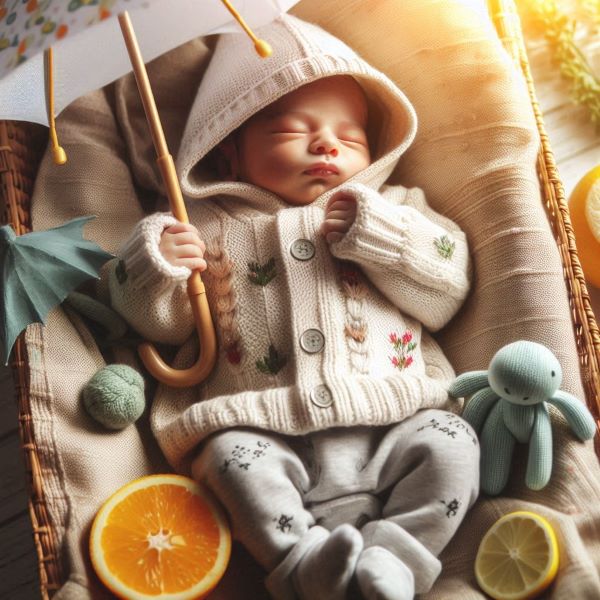The monsoon season, with its cool breezes and frequent showers, brings relief from the scorching heat but also presents unique challenges for keeping your newborn comfortable. The fluctuating temperatures and increased humidity require special attention to your baby’s clothing to ensure they remain warm, dry, and comfortable. This guide provides Clothing Guide for Newborns essential tips and advice on selecting the best monsoon clothing for your newborn. (Source)
Understanding the Needs of Newborns During Monsoon
Newborns have delicate skin and an immature immune system, making them more susceptible to infections and discomfort caused by temperature changes. Proper clothing can help maintain their body temperature, protect their skin, and keep them dry and comfortable. (Source)
Also, read: How to Prevent Monsoon Infections in Newborns: Top Hygiene and Safety Practices
1. Choosing the Right Fabrics– Clothing Guide for Newborns
The fabric of your baby’s clothing is crucial during the monsoon season.
Tips: Clothing Guide for Newborns
- Cotton: Choose breathable cotton fabrics that allow air circulation and absorb sweat, keeping your baby’s skin dry.
- Organic Fabrics: Opt for organic cotton or bamboo fabrics that are gentle on the skin and free from harmful chemicals.
- Avoid Synthetic Fabrics: Stay away from synthetic fabrics like polyester, which can trap heat and moisture, causing discomfort and rashes. (Source)
2. Layering for Temperature Control
Layering clothes is an effective way to manage temperature fluctuations.
Tips:
- Base Layer: Start with a soft cotton onesie or bodysuit as the base layer.
- Middle Layer: Add a lightweight cotton or fleece jacket or sweater for warmth.
- Outer Layer: Use a water-resistant or waterproof outer layer to protect against rain and wind.
- Adjustable Layers: Ensure layers are easy to add or remove to adjust to changing temperatures.
3. Keeping the Head and Feet Covered
Newborns lose a significant amount of heat through their heads and feet.
Tips: Clothing Guide for Newborns
- Hats: Use soft cotton or wool hats to keep your baby’s head warm.
- Booties and Socks: Keep your baby’s feet warm with cotton or wool booties and socks. Ensure they are not too tight to allow proper circulation.
4. Choosing the Right Diapers and Bottoms
Proper diapering is essential to keep your baby dry and prevent rashes.
Tips:
- Disposable Diapers: Use high-quality, absorbent disposable diapers to keep your baby dry. Change diapers frequently to avoid moisture build-up.
- Cloth Diapers: If you prefer cloth diapers, use ones with a waterproof outer layer and ensure they are changed promptly when wet.
- Comfortable Bottoms: Choose loose-fitting bottoms like cotton pants or leggings to allow air circulation and comfort. (Source)
5. Protecting Against Mosquitoes and Insects
Mosquitoes and insects are prevalent during the monsoon, posing a risk of bites and infections.
Tips:
- Long Sleeves and Pants: Dress your baby in long sleeves and pants to cover as much skin as possible.
- Light Colors: Use light-colored clothing to make it easier to spot insects.
- Mosquito Nets: Use mosquito nets over cribs and strollers to protect your baby from bites.
6. Using Swaddles and Sleep Sacks – Clothing Guide for Newborns
Swaddles and sleep sacks provide comfort and security for newborns during sleep.
Tips:
- Swaddles: Use lightweight cotton swaddles to wrap your baby snugly, providing warmth and a sense of security.
- Sleep Sacks: Choose sleep sacks made of breathable fabrics that allow your baby to move their legs while keeping them warm.
7. Maintaining Hygiene and Cleanliness
Keeping your baby’s clothing clean and dry is crucial during the monsoon.
Tips:
- Frequent Changes: Change your baby’s clothes promptly if they become wet or soiled to prevent skin irritation.
- Gentle Detergents: Use mild, hypoallergenic detergents to wash your baby’s clothes to avoid skin reactions.
- Proper Drying: Ensure clothes are thoroughly dried before use to prevent mold and mildew.
8. Using Rain Gear – Clothing Guide for Newborns
Rain gear can be useful when you need to take your baby outside.
Tips:
- Rain Covers: Use rain covers for strollers to protect your baby from rain.
- Raincoats: If you need to carry your baby, consider a lightweight raincoat with a hood.
9. Monitoring for Signs of Discomfort
Regularly check your baby for signs of discomfort or overheating.
Tips:
- Touch Test: Check your baby’s chest or back to gauge their body temperature. If they feel too warm, remove a layer.
- Look for Redness: Watch for any redness or rashes, indicating overheating or moisture irritation.
10. Consulting a Pediatrician
Always consult your pediatrician for personalized advice on your baby’s clothing and care during the monsoon.
Tips:
- Regular Check-Ups: Schedule regular check-ups to monitor your baby’s health and address any concerns.
- Expert Advice: Seek advice on the best practices for keeping your baby comfortable and healthy during the rainy season.
Also, watch web stories: 7 Monsoon Skincare Tips for Newborns
FAQs
Q: How many layers should I dress my newborn in during the monsoon? A: Typically, two to three layers are sufficient. Start with a cotton onesie, add a lightweight sweater, and use a water-resistant outer layer if needed.
Q: Can I use woolen clothes for my newborn during the monsoon? A: Yes, but ensure the wool is soft and not scratchy. Use woolen hats and booties to keep the head and feet warm.
Q: How often should I change my baby’s clothes during the monsoon? A: Change your baby’s clothes whenever they become wet or soiled. On average, you may need to change clothes two to three times a day.
Q: Is it safe to take my newborn outside during the monsoon? A: It’s best to avoid taking your newborn outside during heavy rains. If necessary, use proper rain gear and mosquito protection.
Q: What should I do if my baby develops a rash during the monsoon? A: Keep the affected area clean and dry. Use a mild diaper rash cream and consult your pediatrician if the rash persists.





